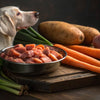How to Make My Own Raw Dog Food: A Complete Guide for Pet Parents
- Houndsy
Table of Contents
- Introduction
- Understanding Raw Dog Food
- Key Components of Raw Dog Food
- How to Make My Own Raw Dog Food: Step-by-Step Guide
- Common Challenges and Solutions
- Exploring Raw Dog Food Recipes
- The Economic Perspective
- Conclusion
Introduction
Imagine watching your dog bound with energy, their coat gleaming, and their eyes bright—signs of a healthful and balanced diet. It's no secret that pet owners are increasingly seeking the best nutrition for their furry friends, leading to a growing interest in homemade raw dog food. In fact, studies have shown that raw diets can lead to healthier digestion and coat conditions among dogs, which is why many pet owners are transitioning to making their own meals.
By choosing to prepare raw dog food at home, we gain full control over what goes into our dogs' bowls. This journey offers an opportunity to address specific dietary needs, improve overall health, and avoid the fillers and additives that may lurk in commercial dog foods. In this blog post, we will explore how to make our own raw dog food, delving into the benefits, required ingredients, recipes, and precautions—all essential for ensuring our pets are well-fed and healthy.
At the end of this comprehensive guide, you will understand the foundational principles of preparing a raw diet for your dog and have access to easy-to-follow recipes that bolster a happier, healthful eating experience for our beloved companions.
Understanding Raw Dog Food
1. What is Raw Dog Food?
Raw dog food is a diet composed of uncooked ingredients, typically including meat (muscle and organ), bones, fruits, and vegetables. This approach aims to replicate the natural diet of dogs in the wild, focusing on fresh, whole foods rather than processed kibbles.
2. Benefits of Raw Dog Food
The transition to homemade raw dog food can provide several advantages:
- Improved Digestion: Raw diets are known to enhance gut health and promote nutrient absorption.
- Healthier Skin and Coat: Many pet owners report shinier coats and healthier skin after switching to a raw diet.
- Better Dental Health: The chewing action required when consuming raw bones helps maintain tooth health and reduce tartar build-up.
- Controlled Ingredients: By making our own meals, we can ensure quality and avoid fillers or artificial additives.
- Customization for Special Needs: Homemade diets allow us to address allergies and sensitivities effectively.
3. Common Misconceptions About Raw Diets
While raw diets may sound intimidating, they are manageable and straightforward with the right knowledge. Many misconceptions surround potential risks, like bacterial contamination and nutritional imbalance. However, with careful preparation and monitoring, these concerns can be effectively managed.
Key Components of Raw Dog Food
1. Essential Ingredients
To create balanced raw dog food, we need to incorporate a variety of ingredients:
- Lean Muscle Meats: The primary protein source; options include chicken, beef, turkey, and lamb.
- Organ Meats: Vital for nutrient density, including liver, heart, and kidney.
- Raw Meaty Bones: For calcium and dental health, sources include chicken necks, wings, and drumsticks.
- Fruits and Vegetables: While not essential, these add fiber and important nutrients. Suitable options include carrots, spinach, and blueberries.
2. Ratio Guidelines
Creating a balanced meal consists of adhering to recommended ratios:
- 60-80% Meat and Offal
- 10-30% Vegetables
- 10% Bones
The specific ratios may vary based on your dog’s size, age, and activity level.
3. Additional Considerations
- Supplements: Depending on our dog’s health needs, it may be beneficial to add supplements, like fish oil or joint support.
- Hydration: Fresh water should always be accessible alongside their meals.
How to Make My Own Raw Dog Food: Step-by-Step Guide
1. Gather Your Supplies
Before we begin, let's prepare our kitchen:
- Large mixing bowl
- Storage containers (ideally BPA-free for safety)
- Antibacterial cleaner for cleanliness
- Food processor or grinder (optional for vegetables)
2. Choose Your Ingredients
To create a basic recipe, let us pick the following components:
Ingredients
- 2 pounds of diced beef
- 1 pound of chicken necks
- 1 cup of chopped vegetables (e.g., carrots, spinach)
- 2 ounces of beef liver
- 1 raw egg (optional)
3. Preparation Steps
- Chop the Ingredients: Start by cutting the beef into bite-sized pieces and roughly chopping the vegetables.
- Mix Thoroughly: In a large bowl, combine the diced beef, chicken necks, vegetables, and beef liver. An optional step would be to add the raw egg for extra protein.
- Portion it Out: Divide the mixture into meal-sized servings, using your containers for easy storage.
- Storage: Store a few days' worth in the refrigerator and freeze the rest to ensure freshness.
4. How Much to Feed
As a general guideline, adult dogs typically require 2-3% of their body weight in food. If your dog weighs 50 pounds, that translates to about 1 to 1.5 pounds of food per day. For puppies, aim for 2-3% of their ideal adult weight.
5. Safety Guidelines
To ensure our canine companions remain healthy while enjoying their raw meals, keep the following in mind:
- Always wash our hands and utensils after handling raw meat.
- Monitor your dog during meal times to prevent choking on bones.
- Consult your veterinarian regularly to ensure your dog's diet remains balanced.
Common Challenges and Solutions
1. Nutritional Balance
One of the significant challenges when transitioning to raw dog food is maintaining a balanced diet. Consider working with a vet or a pet nutritionist to create a tailored meal plan. Regular nutritional assessments can help avoid deficiencies.
2. Ingredient Sourcing
Finding high-quality ingredients might require a bit of effort. Local butchers and farmers’ markets are excellent sources of organic and fresh produce.
3. Time Commitment
Preparing raw dog food takes time and planning. Consider meal prepping in bulk and freezing portions to save time during busy weeks.
Exploring Raw Dog Food Recipes
1. Beef and Chicken Raw Dog Food Recipe
This recipe is perfect for introducing the concept of raw food.
Ingredients:
- 2 lbs of beef, diced
- 1 lb of chicken necks
- 1 cup vegetables (finely chopped carrots or spinach)
- 2 oz beef liver
- 1 raw egg (optional)
Instructions:
- Mix all ingredients thoroughly in a bowl.
- Portion into meals and store appropriately.
- Serve thawed or fresh, and observe your dog’s reaction to the new flavors!
2. Chicken and Veggie Medley Recipe
For variety, consider this chicken-based option.
Ingredients:
- 2 lbs of chicken (thighs or breasts)
- 1 cup of mixed vegetables (zucchini, peas, carrots)
- 1/2 cup of sweet potato, cooked and mashed
Instructions:
- Dice the chicken and mix with vegetables and cooked sweet potato.
- Portion out and store in the freezer.
The Economic Perspective
Is It Cheaper to Make My Own Raw Dog Food?
The cost of homemade raw dog food can vary significantly based on the ingredients chosen, local availability, and purchasing methods. While it might seem like a higher upfront cost, sourcing in bulk can lead to savings. Furthermore, the investment in your dog's health often outweighs the cost when considering reduced vet visits and a longer, happier life for our furry friends.
Conclusion
Making our own raw dog food can be a rewarding experience, offering us greater control over our beloved pets' nutrition while potentially improving their health. Though it requires some initial effort and education, the benefits of enhanced vitality and the joy of nourishing our pets make it worthwhile.
As we embark on this journey of crafting nutritious meals for our dogs, remember to keep the process enjoyable and engaging for both ourselves and our furry companions. Let's explore transitions like this with the same excitement we feel for their wagging tails.
If you're ready to elevate your dog's feeding experience, consider integrating a product like the Houndsy Kibble Dispenser to streamline mealtime. This innovative solution takes the hassle out of feeding while ensuring that mealtime remains a taste of joy!
FAQ
1. Can homemade raw dog food be harmful?
If prepared properly and balanced nutritionally, homemade raw dog food should not harm your dog. It’s essential to ensure the diet meets AAFCO standards and regularly consult a veterinarian for dietary advice.
2. What should I do if my dog doesn’t adjust well to a raw diet?
Transition slowly by gradually increasing the amount of raw food while decreasing their previous diet. If problems persist, consult your vet for tailored solutions.
3. How often should I feed my dog raw food?
Feeding frequency will depend on your dog's age and health. Generally, adult dogs do well with once or twice a day feeding, while puppies may require three meals.
4. How do I safely handle and store raw dog food?
Practice proper hygiene by washing hands and surfaces thoroughly after handling raw food. Store prepared meals in airtight containers in the freezer, thawing only what’s necessary for day-to-day feeding.
5. Is it really worth switching to a raw diet?
Many dog owners report significant improvements in their pets' health and energy levels after transitioning to a raw diet, making it worth the effort for many. However, always consider individual needs and consult with professionals when necessary.













